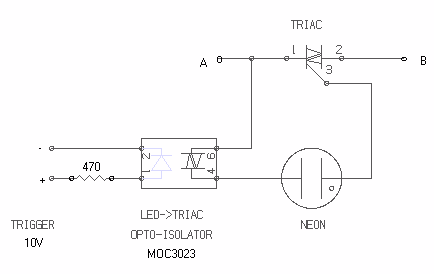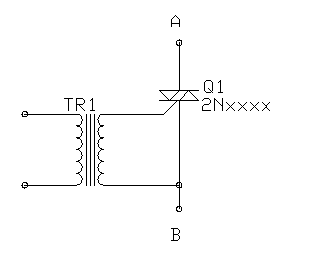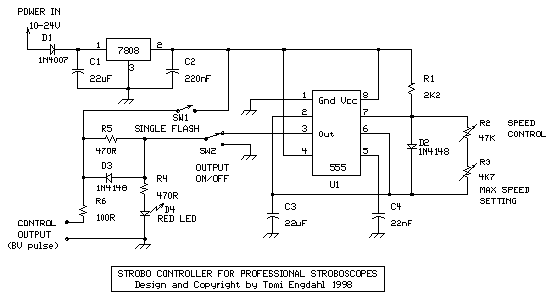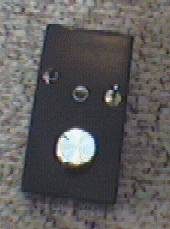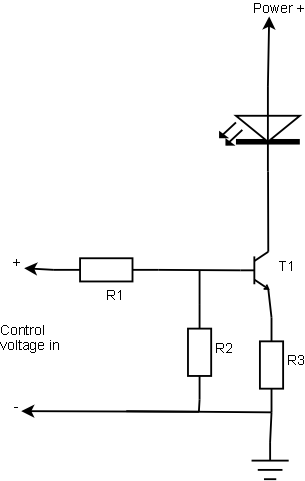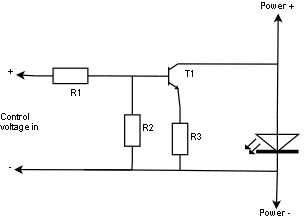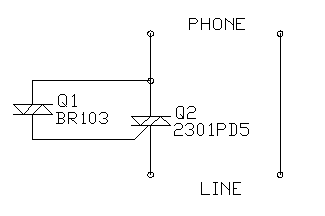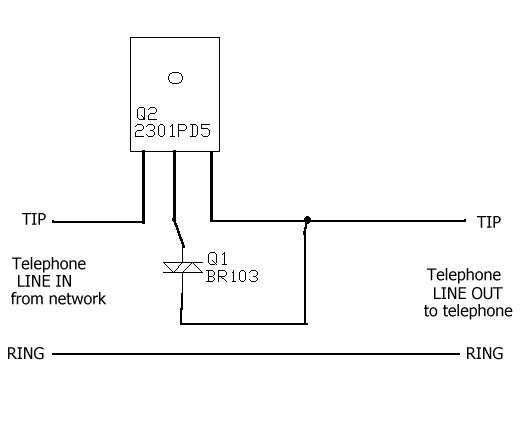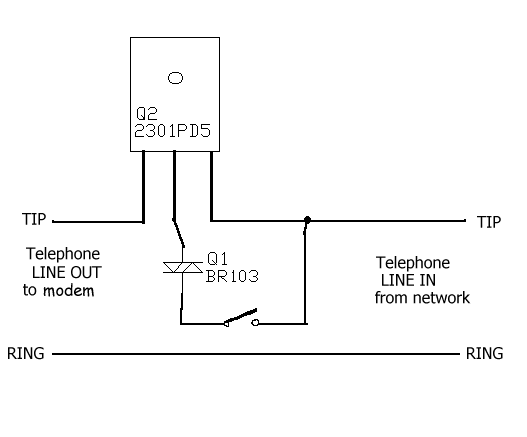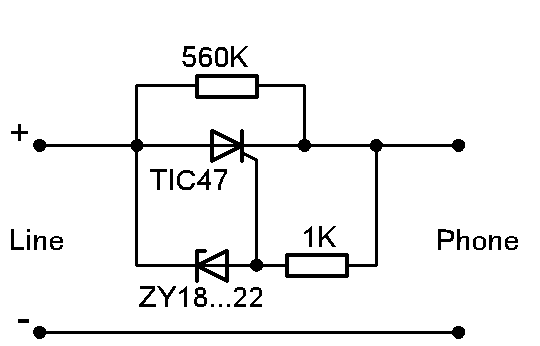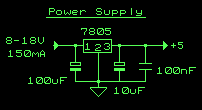Preface
Telephone circuit gain always interrest, because telephones are everywhere and quite often there are old telephone luying around somewhere. Those telephones can be used for many interresting experiments including small home intercom: connect telephones in series or parallel and feed suitable operating current (about 20 mA) to them through resistor from power supply.
The most problematic to home experimenter is how to get telephone ringing because the ringing voltage is over 50V and not at standard mains frequency (50/60Hz). Sometimes you want to get the information that telephone is ringing to your own circuits. This text tries to clear out those problems.
What is ring signal ?
The telephone company sends a ringing signal which is an AC waveform. Although the common frequency used in the United States is 20 HZ and in Europe is typically 25 Hz, it can be any frequency between 15 and 68 Hz. Most of the world uses frequencies between 20 and 40 Hz. The voltage at the subscribers end depends upon loop length and number of ringers attached to the line; it could be between 40 and 150 Volts. The ringing cadence - the timing of ringing to pause - varies from telephone company to company.
The usual arrangement is to feed the 75 V a.c. ringing current (backed by earth) down one wire of the phone line. On the other wire is placed a slugged relay (or equivalent) which is backed by -48V d.c. When you pick up the phone, the relay operates to the loop d.c. current and trips the ringing current. It also triggers a further device to put the transmission bridge in circuit to enable speech to take place, together with supervision of the calling and called loops. The ralay needs to be a slugged relay to prevent premature ring trip by the a.c. ringing current.
In USA minimum ring voltage supplied is 40Vrms (delivered into a 5 REN load). This is the must detect limit. There is also a minimum must ignore value of 10Vrms. Milage on individual PBX's will vary greatly. But most guarantee to deliver 40Vrms into a 3 to 5 REN load.
When the telephone ring signal is sen to the telephone, the ring voltage is not applied constanly to the line. Typically ring timing is 2 seconds on and 4 seconds off in the US. In the UK ring timing goes .4 sec on, .2 sec off, .4 sec on, 2 sec off then repeats. In toher countries the ring timign cna vary from country to country (even from operator to operator) and you should check the local regulations if you want to get to know the actual ring signal timing in use.
For more information, check Understanding Telephones article by Julian Macassey at http://www.epanorama.net/counter.php?url=http://www.egyed.com/phonework.html and appropriate BellCore documents.
What is REN ?
REN stand for Ringer Equivalen Number. It is a measurment of how mugh ringing power certain telephone equipment takes. REN numbers are used in USA to determine how many telephoen equipments you can connect to same telephone line and still get them ringing properly (typical line can drive about 3-5 REN load).
The definition of 1 REN is the ringer power required by one ringer of an AT&T standard 500 series telephone set in single-party configuration (ringer placed ACROSS the line). One place to find the exact info: get a copy of 47CFR Part 68 - this is the FCC technical specs (and other info) regarding the PSTN (public switched telephone network). This info also may be available from the FCC's web site.
What is ringing tone ?
Ringing tone is the ringing that can be heard while the receiver is on-hook and somebody tries to call you. The terms used for describing this telephone ringing are not always very clear whet they mean, because the same term has been used in differnet places to mean different things. ITU-T Q.9 indicates the preferred term is "ringing tone", but that "ringback tone" is used in the USA. On the other hand, Bellcore (and the old Bell System), used "audible ringing tone" in many of their documents. In 5ESS switch documentation (according some news articles), RINGBACK is used only to describe various ways (other than a normal terminating call) by which a subscriber's telephone may be rung. Usually people say "ringback" in place of "ringing tone".
What is distinctive ringing
Distinctive ringing is a system where different ringing tone patterns can tel different thing about the telephone calls. Typical applications are PBXs where you can identify if the call is from inside buildign or from outside by hgearing different ring pattern. Aother applications are when multiple phone numbers are assigned to one physical line and the rign pattern tells which number of them has been called.
Distinctive Ringing and Call Waiting patterns and timing use in USA are covered in GR-506-CORE. Use of multiple patterns to identify the CALLED party (multiple DNs per line) is covered in the basic LSSGR (GR-505 and GR-506 in particular), in the ability to assign ringing patterns to numbers and to Centrex services. ANSI T1.401 identifies some other requirements for distinctive ringing involving inter-exchange carriers.
Normal telephone wiring
In normal telephoen wiring (used in Finland, USA and very amny other countries) the telephoen audio and sing signals share the same wire pair. Typical wiring for 6 pin modular connector:
1
2
3 a-wire
4 b-wire
5
6
A and B wires make the pair which telephone used. Typicslly the modular connectos used in telephone have only 2 or 4 pins installed. Normally unused pins are used for wiring more than one line to same connector or for some special applications.There are also many other types of telephone line connectors in use, but nowadays this modular connector is the most common in telephone terminal equipmens like telephones with removable cord, modems and FAX machines.
Special cases in ring signal wiring
On some coutries the ring signal is fed to the customer telephoes using one extra wire. The UK wiring tetails are available in separate UK wiring document.
Ringer circuits in telephones
Classical bell type ringer
The most classical telephone ringer circuit is a mechanical bell controlled by an electronic coil. The circut consists of the bell coil and a capacitor (usually 470 nF to 2 uF rated for 250V or more) in series with it. This circuit is connected in parallel to other telephone electronics. The capacitor in the circuit stops the DC in to pass through the bell coil, but it lets the ring voltage through easily. Because of mechanical nature of the ring circuit, it is very sensitive to the frequency of ring voltage and other than the resonance frequency of the bell system (usually around 20-25 Hz) do not generate satisfactory ring.
The coil has usually so high impedance that it does not disturb the telephone audio circuit operation when telephone is off-hook. Other possiblity is that the ring circuit is disconnected when the telephone is picked off-hook.
Electronic ringers
The ringer circuits in the modern telephones have the same basic idea, but the coil controlled bell is replaced by modern electronic ringing chip and small speaker. The capacitor is still used in series with ring IC input to make only AC pass to the ring chip. The electronic ringing circuits are not sensitive to the ringing voltage and they easily ring with ring signal frequencies between 16 Hz and 60 Hz.
Ring detection circuits in modems
In computer modems the logical signal from ringing is needed instead of ringing tone. The ring circuit must pass the ring signal information to modem electronics and still provide electrical isolation between telephone line and modem electronics. This ring detection is usually done using one optoisolator circuit, which replaces the raditional ring circuit. The optoisolator output can be easily connected digital electronics, but the optoisolator input side needs more electronics: one capacitor for not letting DC to pass through optoisolator, one resistor to limit the cirrent passing through optoisolator LED and one reverse conencted diode in parallel with optoisolator LED to prevent negative voltages from damaging the LED. This is the basic ring detection circuit.
Usually there is also two zener diodes (usually 10-20V models) to make sure that the ring detection circuit does not detect too small AC signals in the line as ring signal. In the picture below you see a very typical ring detector circuit for modems. The circuit just gives the idea how modem ring detector circuit work. The actual component component values selection must be so that the circuit meets the national telephone regulations (this can be usually easily done by using suitable zener diodes and maybe chancing the resistor value a little).

Component list:
C1 470 nF 250V AC
R1 10 kohm 1W
D1,D2 10-20V zener diode (any value in this range), 400 mW power rating
D3 1N4148 diode or equivalent
U1 4N27 optoisolator or similar
NOTE: You can get the circuit work by taking out D1 and D2 and replacing them with a short circuit. The circuit works after then, but it is possible that in this case some low voltage noise on the line can cause the circuit to ring. Different countries have different specifications on how low voltages should not cause a telephone to ring at all.PS. If you are interrested in using theis cirucit as basis for controlling some high power cirucitry take a look athttp://www.epanorama.net/counter.php?url=http://www.aaroncake.net/circuits/pflash.htm for a circuit example how to drive a relay when ring is detected.
Another apprach for ring detecting is to use a full wave rectifier circuit to convert the AC sign signal to the DC suitable for optoisolator and then put current limiting resistor and zener diode to the rectifier output.
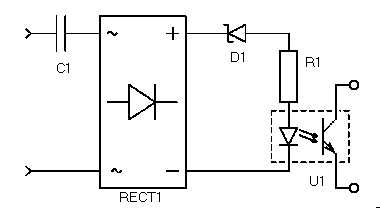
Component list:
C1 470 nF 250V AC
R1 10 kohm 1W
D1 10-20V zener diode (any value in this range), 400 mW power rating
RECT1 Rectivifier bridge 200V voltage ratign, at least 0.1 current rating
U1 4N27 or CNY17 optoisolator
Other ideas to detect telephone ringing
One idea which is proposed in many sources is to use small neon bulb (like those used as lights in some mains switches) for detecting the ring signal. The circcuit proposed is to connect one neon bulb and 47kohm resistors in series and connect this to telephone line. The neon bulb has about 60V trigger voltage to start conducting, so standard 48V telephone battery voltage does not light it. When the AC ring signal is added to that voltage, the voltage is enough to light the neon bulb. The neon bulb can be used as visual indicator or electronics can sense it with LDR photoresistor or phototransistor.
If you don't want to build your own circuit from neon bulb and resistor, there is an even easier solution is to go down to the hardware store and get a "pigtail" tester. It has two nice leads that one normally pokes into the wall outlet to test for voltage. Wire it instead to the phone line. This saves the hassle of trying to find the container for the neon lamp, and the resistor (which is VERY necessary, take my word for it).
One modem schematic I have seen used quite special method for detecting ringing signals: It had a small capacitor in parallel with on-hook/off-hook control relay contacts. This capacitor let some small part of the sound and ring signals pass to the telephone transformer. In this way those ring signals can be detected as small signal pulses in transformer secondary (and this circuit can be also used for Caller ID signal detection). The capacitor was so small that the impedance seen from telephone line stays high enough not to disturb other equipments in the same telephone line when modem is no on-line.
What telephone regulations say about telephone ringers
European NET4 telephone line terminal equipment specs define the following specs for the telephoen ringing detector circuit.
- The impedance in voice frequency (200-3400 Hz) must be greater than 10 kohm when measured with 0.5V RMS audio signal
- The current taken by the ringer must be equal or less than 5 mA at 35 V ring voltage and equal or ledd than 10.7 mA at 75V ring voltage. The measurments are made using 25 Hz ring current frequnecy.
- Ring detector must work on ring signal which is 44-58V DC summed with 25+-3Hz AC ring signal in voltage range 35-75 V. The feeding resistance for ring generator is 800-1710 Hz.
- Ring detector must not detect ring signal which is 44-58V DC summed with 20-3400 Hz AC ring signal which is less than 10 V. The feeding resistance for ring generator is 800-1710 Hz.
If the equipment is automatically responding the equipment must wait at least 1s from the ring detection until it goes off-hook.
Telephone ringer classification
In USA FCC regulations need the ringer type to be specified on the device. The possible types are Class A and Class B. Class B ringers will respond to ringing frequencies of between 17 and 68 Hertz while Class A ringers will respond to betwwen 16 and 33 Hertz. Class A devices are those typical old telephone bells and practically all electronic ringers are B type. Nearly all of the devices made to connect to the phone lines today are of the Class B type. The telephone ringer type on your device (if you live in USA) is printed on the FCC sticker on the bottom with a REN number on it. You'll see something like .9B (= REN 0.9 Class B) or 1.0A (= REN 1.0 Class A).
How to make telephone ring
The following ideas are simple circuits, which generate ringing voltage at mains frequency (50 or 60Hz depending on country). They will ring modern telephones very well, but the rign sound might not be actually the same as with right ringing signal. If that is not a problem, then go on. The ring signal at 50 or 60 Hz does not work with old telephones which have mechanical bells in them.
Direct connection to mains
This approach has been proposed many times at rec.theatre.stagescraft newsgroups but I strongly suggest not to use it. Mains voltage (120V AC 60Hz) used in USA makes the modern telephones ring, but it is dangerous to make direct connection to mains voltage. And if you don't use any type of current limiting, the telephone will cause dangerous short circuit when it is picked up. The telephone will destroy and put out smoke.
50/60Hz ring voltage generated from mains voltage
If you want to use very simple circuit for ringing, I would suggest following combination: a small ready made AC adapter which puts out AC and a small transformer connected to it. If you use suitable tranformer combination, you will get nice 70-90V AC voltage at you mains voltage frequency (50 or 60 Hz). Ready made wall adapter will provide provide isolation from mains voltage and also limit the current in short circuit situation.
Suitable comination for example is wall adapter which outputs 8-9V AC at 200-500 mA connected to transformer which has 120V primary, 12V secondary and power handling capacity of few watts. The wall adapter is connected to transformer's 12V secondary through a button. When the button is pressed, there is about 70-90V AC available at transformer's primary winding. For current limiting it is a good idea to put 1 kohm 3W resistor in series with transformer's secondary. If you can't find transformer I told earlier, remeber that many transformers with 220V primary winding have center tap connection for 110V voltage wiring. And if there is not centre tapped 220V transformer, you can always use 220V to 24V transformer. If your wall transformer has different rating, the scale the transformer's values according that. The component values in this circuit are not critical, but keep in mind that the voltage of transformer's secondary must be grater thatn the output voltage of the wall adapter.
And for your safety, build this circuit to a good box in which you have telephone connector on one side. And be careful with the circuit not to get shocked because the 50/60Hz ring voltage is more dangerous than normal ring voltage.
Methods for generating good ring voltage
Ringer module
The easiest way to get real ringing module. Those units are available from some companies which make DC/DC converters for telecommunication industry. Migh not be the easiest component to get.
70V line PA amplifier
The output voltage of PA amplifiers designed for driving 70V speaker system speakers have enough output voltage and power for ringing telephones. If you have old this type of amplifier lying somewhere, you can connect the amplifier input to fuction generator and output to telephone through 1 kohm 3W resistor. When you set the function generator to generate sine wave at 20-25 Hz at suitable level for amplifier, you have an adjustable level ring generator. Usually those amplifiers are not good at playing back frequencies below 50 Hz, so you might have to try higher frequencies if that does not work as expected.
Normal audio amplifier and transformer
Very nice variable amplitude ring generator can be built from audio amplifier designed for driwing 4 or 8 ohm speakers and have output power of 3W or more, 10 ohm 10 W resistor, 220V to 12V transformer (few watts), 1000 ohm 3W resistor and function generator.
___________ 10 ohm 1000 ohm
| |----/\/\/\--+ ||(---/\/\/\---
| | | ||(
Sinewave----| Amplifier | )||( Ring voltage out
| | | ||(
|___________|------------+ ||(------------
Transformer
12V:220V
The circuit is easy to build. Connect 10 ohm resistor in series with transformer's secondary winding and 1000 ohm resistor in series with primary winding. Connect the primary winding side of the transformer to amplifier's speaker output. Connect the telephone to the secondary side. The resistors are in the circuit to limit the current and to keep the impedance high enough for the amplifier.
When you have done this, connect you function generator to amplifier's input and set it to generate 20-25 Hz sine wave at suitable level for amplifier's input. Turn down the volume of the amplifer. Turn the amplifier on. Turn the volume up until you hear telephone ringing well. You can check the ringing voltage with multimeter if you vat to make it to exactly right level.
Modified power inverter circuit
It is possible to make 17 - 25Hz a.c. from d.c. A simple multivibrator will do it. You then need a power transistor or similar to give the high-current output. A suitable circuit can be modified from typical power inverter circuit by changing the timing components to make the frequency to 20-25 Hz range. Then the transformer needs to be selected so that it matches this application (for 12V operation take a mains centre-tapped 60V (30+30V) secondary and 230V primary).
Dedicated ringing generator circuit
There have been telephone ringer circuit in major electronics magazines and circuit books. Those circuit are good idea when you want to build the circuit from base components.
There are commercial units specifically made fro ringing telephone. TELE-Q is a device designed for ringing telephone theatre effect. That unit is available from Norcostco for little over 100 US dollars. I have no experience in this product but it has been suggested in many usenet news articles.
Maplin Electronics has a phone ringer electronics kit which can give out UK and USA type ring styles. It has been reported to work uite well with any modern telephone, though it has said to struggle slightly to drive old fashioned bell types which need lots of ring current.
There are also telephone line simulators available from some tecom equipment manufacturers. Those telephone line simulator boxes also usually include the ringer circuit. Two examples are Viking Electronics Line Simulator/Ringdown Circuit and Jech Tech Phone Helper. Usually complete line simulators are more expensive than simple ringer circuit but they have more uses also (you can make two telephones an intercom etc.).
Generating ring pattern
Normal telephone ringing signal the central office sends is not normally contirnuous signal, but follows some pattern. The pattern could be for example ring 2 seconds on, four seconds off and then again 2 seconds on, 4 second off etc.. The patterns used can vary somewhat from country to country.
If you want to generate this kind of pattern you need a timer circuit that generates 2 seconds on and 4 secodns off type output signal. That signal is then used to control a relay that switches the power from the power source going to telephone and off. A 555 timer and one relay can nicely do this. Basicly you take 555 timer in normal astable mode and then select the value fo two resistors and one capacitor. Then connect relay to 555 output, and that should do it.








